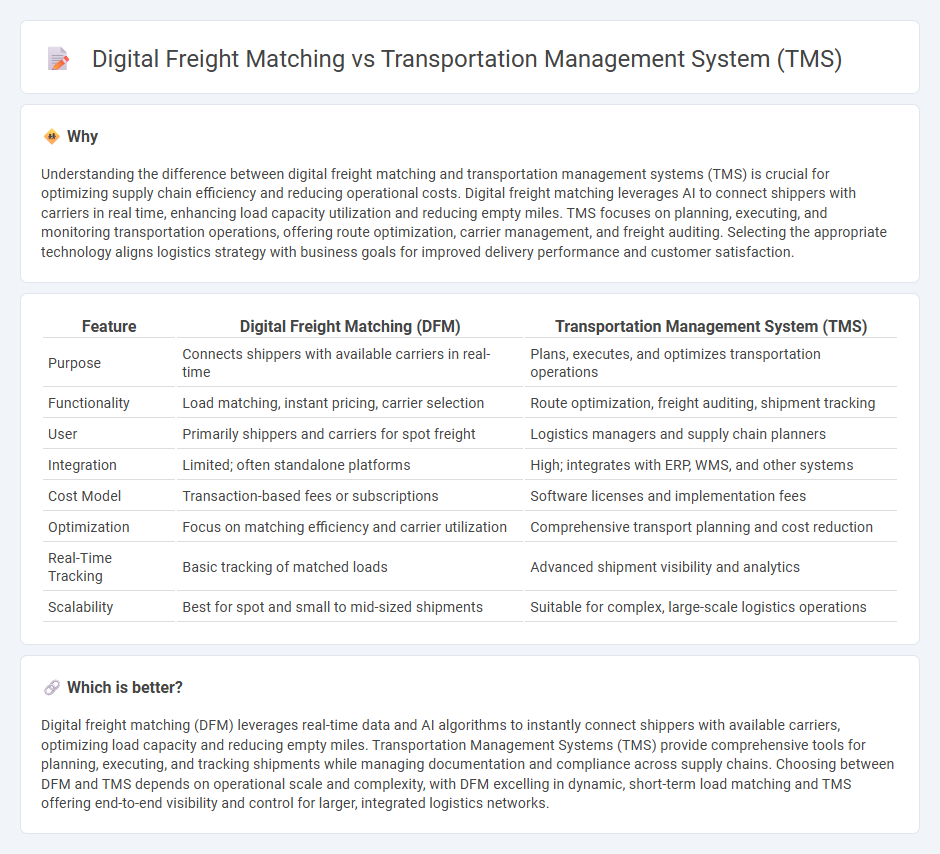
Digital freight matching (DFM) streamlines the shipping process by connecting shippers with carriers in real-time using advanced algorithms and mobile platforms, enhancing load capacity utilization and reducing empty miles. Transportation Management Systems (TMS) provide comprehensive logistics solutions by managing planning, execution, and optimization of freight movement across multiple carriers and modes, integrating route planning, load tendering, and freight auditing. Explore how combining DFM and TMS technologies can maximize operational efficiency and cost savings in modern logistics networks.
Why it is important
Understanding the difference between digital freight matching and transportation management systems (TMS) is crucial for optimizing supply chain efficiency and reducing operational costs. Digital freight matching leverages AI to connect shippers with carriers in real time, enhancing load capacity utilization and reducing empty miles. TMS focuses on planning, executing, and monitoring transportation operations, offering route optimization, carrier management, and freight auditing. Selecting the appropriate technology aligns logistics strategy with business goals for improved delivery performance and customer satisfaction.
Comparison Table
| Feature | Digital Freight Matching (DFM) | Transportation Management System (TMS) |
|---|---|---|
| Purpose | Connects shippers with available carriers in real-time | Plans, executes, and optimizes transportation operations |
| Functionality | Load matching, instant pricing, carrier selection | Route optimization, freight auditing, shipment tracking |
| User | Primarily shippers and carriers for spot freight | Logistics managers and supply chain planners |
| Integration | Limited; often standalone platforms | High; integrates with ERP, WMS, and other systems |
| Cost Model | Transaction-based fees or subscriptions | Software licenses and implementation fees |
| Optimization | Focus on matching efficiency and carrier utilization | Comprehensive transport planning and cost reduction |
| Real-Time Tracking | Basic tracking of matched loads | Advanced shipment visibility and analytics |
| Scalability | Best for spot and small to mid-sized shipments | Suitable for complex, large-scale logistics operations |
Which is better?
Digital freight matching (DFM) leverages real-time data and AI algorithms to instantly connect shippers with available carriers, optimizing load capacity and reducing empty miles. Transportation Management Systems (TMS) provide comprehensive tools for planning, executing, and tracking shipments while managing documentation and compliance across supply chains. Choosing between DFM and TMS depends on operational scale and complexity, with DFM excelling in dynamic, short-term load matching and TMS offering end-to-end visibility and control for larger, integrated logistics networks.
Connection
Digital freight matching platforms streamline the transportation process by connecting shippers with available carriers in real time, enhancing load visibility and reducing empty miles. Transportation Management Systems (TMS) integrate these platforms to optimize route planning, carrier selection, and shipment tracking, driving operational efficiency. This seamless integration improves freight allocation accuracy, lowers transportation costs, and accelerates delivery timelines across the supply chain.
Key Terms
**Transportation Management System (TMS):**
Transportation Management System (TMS) streamlines logistics operations by optimizing route planning, carrier selection, and freight payment processes, enhancing overall supply chain efficiency. It integrates real-time data analytics and automation to reduce costs, improve delivery times, and increase visibility across shipments. Discover more about how TMS can transform your transportation strategy for maximum operational excellence.
Route Optimization
Transportation Management Systems (TMS) utilize advanced algorithms and real-time data integration for optimized route planning, reducing transportation costs and improving delivery efficiency. Digital Freight Matching platforms focus on dynamically pairing shipments with available carriers, often leveraging AI to streamline load allocation and minimize deadhead miles. Explore how these technologies revolutionize route optimization by evaluating their distinct approaches and benefits.
Carrier Selection
Transportation Management Systems (TMS) streamline carrier selection through integrated data analytics, carrier performance metrics, and automated routing capabilities, optimizing freight efficiency and cost control for shippers. Digital freight matching platforms use real-time load matching algorithms and carrier availability to quickly connect shippers with independent carriers, emphasizing speed and flexibility in transport assignments. Explore deeper insights into carrier selection strategies and technology benefits for supply chain optimization.
Source and External Links
What is a Transportation Management System (TMS)? | Manhattan - A TMS is a supply chain software solution that manages, plans, optimizes, and executes logistics for transporting goods, providing benefits like route optimization, real-time visibility, fleet coordination, automation, and improved planning to increase profitability and customer satisfaction.
Transportation management system - Wikipedia - A TMS acts as an intermediary between ERP/order processing and warehouse modules, helping evaluate routing options, select cost-effective transportation modes, execute shipments, and support freight audit and payment processes, offered in various licensing models including SaaS and on-premises.
What Is a Transportation Management System? | Oracle - A logistics platform that uses technology to plan, execute, and optimize the movement of goods, ensure compliance, provide shipment documentation, and integrate with broader supply chain management systems to streamline shipping and improve transportation operations efficiency.
 dowidth.com
dowidth.com